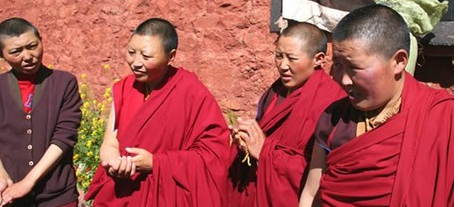Drolma Lhakhang-Explore Tibet.

Atisha is the honorific Sanskrit name given to Dipamkara shri jnana, the Indian Buddhist master from Bengal who was instrumental in the so-called second dissemination of Buddhism in Tibet.Atisha or Jowoje (precious lord) as he is called by the Tibetans, was born to a noble family in Bengal in 982. He renounced his home and wealth at an early age and dedicated himself to the extensive study of Buddhism. He even traveled as far as Java to receive instructions on the development of the compassionate resolve at attain enlightenment. Upon his return to India he taught widely and became one of the most revered Buddhist teachers of his time, probably settling at the Vikramashila monastery. In the early decades of the eleventh century Buddhism started to revival in Tibet. The communities of monks who had been living in the east of the country since the time of langdrama began to return to central Tibet. In the west the Tibetan Rinchen Sangpo had returned from eighteen year’s study in India and was actively teaching and translating Buddhist scriptures. It was also from the western kingdom of Gegu that the local king, Lha Lama Yeshi sent out repeated invitations to the greatest Indian teachers of the time, Atisha to visit Tibet. After much supplication and personal sacrifice from the Tibetans, Atisha finally accepted and arrived in western Tibet in 1042, aged sixty. His teaching aimed at resolving the conflicts that were present within the Buddhist community of Tibet at that time. Above all he emphasized the need for a sound ethical basis before engaging in the more advanced tantric practices, He composed a short text, The lamp of the path to enlightenment; it became the basic writing of the Kadampa school, which formed after his death under his chief disciple, the layman Drom Tonpa. He spent a total of twelve years in Tibet. He spent his last year in Netang and died here in 1504. Since he death, the Drolma Lhakhang, dedicated to female deity Tara, with whom he had a particularly strong connection, has been preserved as a shrine in his memory. The drolma Lhakhang was one of the few religious sites to escape much damaged during Cultural Revolution. The temple was spared because of a request from Bengali government that no harm be caused to the most sacred sites of Atisha.Even today a revered national figure in Bengal. Consequently, the images preserved in the temple are fine examples of the Tibetan religious art and craftsmanship of the eleventh century, often reflecting a distinct Indian influence that is no longer so evident in more recent works.
Recent Posts
The Ultimate Guide to Tibet Tours, Travel, and Trekking Adventures
How to Explore Tibetan Culture
Exploring Lhasa:The Heart of Tibet
All Categories
- About Tibet
- book a Tibet tour
- Buddhism Practice
- Budget Tour
- China-Tibet Train
- Customized Tibet tour
- Historical Sites
- Hot Springs in Tibet
- News
- Photography in Tibet
- Tibet attraction
- Tibet Group Visa
- Tibet Motorcycle Tour
- Tibet Small Group Tours
- Tibet Tours and Tibetan Tour Guide
- Tibet Train
- Tibet Travel FAQs
- Tibet Travel Information
- Tibet Travel News
- Tibet Travel Permit Update
- Tibet Travel Prices Rises
- Tibet Trek
- Tibet Trekking Tour
- Tibet weather and climate
- Tibet Wildlife animals
- Tibet Winter Tour
- Tibetan Buddhism
- Tibetan Cultural Features
- Tibetan Culture and Poeple
- Tibetan Festivals
- What to see in Tibet



